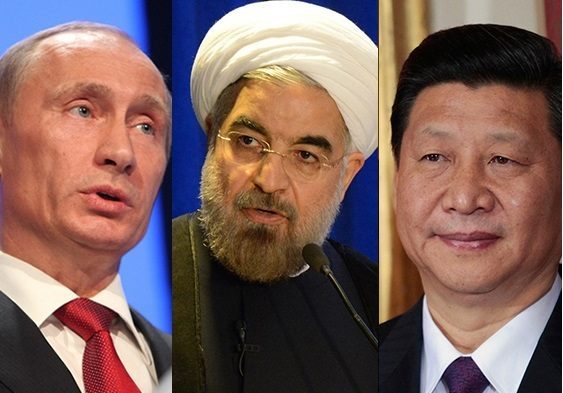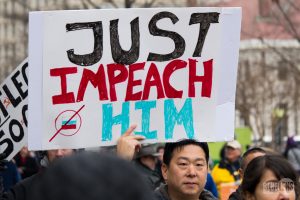by Esfandyar Batmanghelidj
“Today, Russia and China effectively shelter Iran from complete isolation and provide it with political support, defence assistance, and economic ties it cannot receive elsewhere.” That is the primary contention of a new book by Dina Esfandiary, a research fellow at Harvard’s Belfer Center for Science and International Affairs, and Ariane Tabatabai, an assistant professor at Georgetown University’s School of Foreign Service.
Triple Axis (I.B. Tauris) explores “Iran’s ability to leverage its relations with Russia and China” as part of the Islamic Republic’s “struggle to challenge the world order.” The book is divided into five sections. First, the authors examine Iran’s position in the world order and the shared project of a Russian-Chinese-Iranian bulwark against the West. Second, the authors chart Iran’s evolving political relations with the two powers from the Cold War through the negotiations which led to the Joint Comprehensive Plan of Action (JCPOA). Third, they discuss economic ties, with a particular focus on the increasing presence of Chinese enterprises in Iran’s economy. Fourth, they examine defense and security cooperation, with an in-depth look at Iran-Russia cooperation in Syria. Finally, they conclude by looking to the “post-JCPOA” prospects for the triple axis, particularly in the face of a breakdown in the cohesion of American and European foreign policy towards Iran. It is in this last section that Triple Axis becomes theoretically most interesting.
Esfandiary and Tabatabai bring their narrative up to the present day when European policymakers are scrambling to save the JCPOA following President Trump’s withdrawal from the deal in May. Iran is rightly concerned that the reimposition of US secondary sanctions will further stymie the already slow rebound in trade and investment that underpinned the quid-pro-quo of the nuclear deal. Even as Europe seeks to define—for the first time in a decade—an Iran policy independent from that of the United States, it will likely prove unable to mitigate the harm of the returning sanctions. By all accounts, the Trump administration’s financial war is going as planned, as Iran’s currency plummets in value and shortages in key goods contribute to widespread protests. In this environment, Russian and Chinese companies, less concerned with the risk of US sanctions, will once again prove Iran’s lifeline.
Russian and Chinese efforts to sustain Iran economically, in the absence of significant Western trade or investment, will “translate into more intertwined interests” that combine basic commercial opportunities with larger political and military interests. Ultimately Russia and China will face “greater difficulty in walking away” from the alliance. Consequently, Esfandiary and Tabatabai see the crisis surrounding the nuclear deal as accelerating a process that will “effectively make any future Western attempts to isolate Iran unfeasible.”
The notion that American efforts to isolate Iran are tantamount to America isolating itself is now a ubiquitous touchpoint in policy analysis on Iran. In one recent example, a Newsweek headline blared “US Risks Losing World Power to China and Russia by Splitting with Allies on Iran.” Despite these looming fears, there have been few in-depth studies that elucidate Iran’s political and economic relations beyond the West.
Triple Axis provides a single, authoritative assessment of the strategic relations between Russia, China, and Iran. Esfandiary and Tabatabai are effective at this task largely because of their strong instincts as analysts of Iran, honed in part through a considerable number of interviews conducted with Iranian officials on the sidelines of the nuclear negotiations and during subsequent diplomatic visits to Europe and the United States.
Although Triple Axis makes the content of Russian and Chinese public diplomacy towards Iran clear, it remains less clear to what extent Russian and Chinese strategic designs diverge with the image publicly presented. Iranian officials are clearly worried about this divergence in both political and economic spheres, viewing Russia and China as “untrustworthy partners.” Esfandiary and Tabatabai point to the sources of this distrust. On the warfront in Syria, Iranian officials “continued to view Russia with suspicion,” for instance that it might make a deal with the West to Iran’s detriment. Meanwhile, concerning Chinese investments, Iranians had their own grievances about lackluster project management and the low quality of imported goods.
These failures of trust point to the difference between relationships of convenience and deeper partnerships. Iranian officials are realistic about the limits of relations with Russia and China. Of course, Iranian leaders would like to see both powers as their strategic partners, despite disagreements and disappointments. The title of the book seems to describe such an Iranian mentality: an alignment of three equal powers.
But as any sober assessment makes clear, Iran is a regional power whereas Russia and China are global powers. Esfandiary and Tabatabai acknowledge this power differential at the outset. All three states share “an alternate vision to the US-led Western world order” but vary in their capacity to implement their visions. Although this power differential places Russia and China in a position to “shelter” Iran, it also enables the bear and dragon to dominate the Persian cat.
It would be easy to imagine two analogues of this book, one focusing on the Chinese assessment of the tripartite relations and another from the Russian angle. At the very least, the analysis in Triple Axis would have benefited from greater insight from Russian and Chinese officials in order to try and probe whether the very idea of a triple axis may be an overstatement of strategic alignment. The authors allude to such realism in the very last paragraph of the book when they state that “both Russia and China will not hesitate to walk away from Iran should economic, political, and/or military ties no longer be useful to them.” But what are the trigger points for the dissolution of the triple axis? This is a question to be answered in the further studies this important work will surely inspire.






I am not affiliated with anyone. I have my own current affairs blog called Iran News Blog. Google it. I am an Iranian Astrologer. Please do not try to put me in any other category.
This is stating the obvious and doesn’t take a genius to figure it out. What is missing in the analysis is a sophisticated theoretical framework that takes us beyond the typical journalistic and empiricist narrative seen in the writings of the two authors. They have a simple functionalist lens that renders their analysis of very limited heuristic value, but since it’s their first book they can be forgiven!
It seems the discussion centers on sustainability and strategic inter-relationship between the three nations. I think with the current environment the salient point would be of shorter range: the manner in which Iran will survive the multiple challenges that it has from economic stagnation, civil unrest, drought, to dissonance between its stated goals and enactment/enforcement of those goals. In summary, the challenge is management of short range vs. long range strategic partnerships. Given the EU inability to effectively stymie withdrawal of its enterprises from Iran, and the chaotic domestic Iranian theater, a “deep dive” rescue effort primarily by China (who possesses the wealth to do so) would be needed to bring some normalcy, albeit marginal, to Iran. In Addition to the Chinese connection, with the impending November US elections and the chance for Democrats to regain control of the House, the vice gripe that is in place might loosen somewhat for Iran, given the desire by the Democrats to salvage some of the JCPOA legacy. Time will tell.